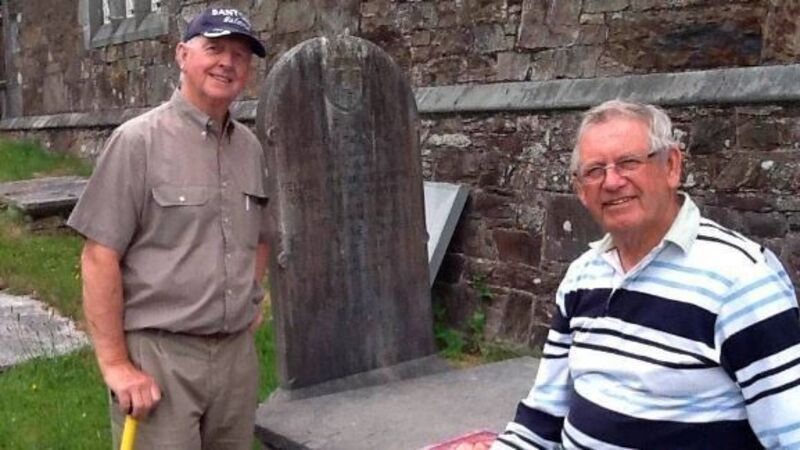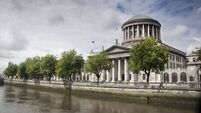Leaving a mark so we will not forget

The youngest was Lugna, and a stone discovered there bore the inscription “Lie Lugnaedon Macc Lmenueh” which scholars Petrie and O’Donovan have translated as “The stone of Lugnaedon (or Lugnaed) son of Limrnueh.”
This Lugnaed was identified with Patrick’s nephew, and was the only saint to beat this name in Irish ecclesiastical history.
Your local graveyard may not yield such immediately obvious historical treasures, But those headstones and markers used to record the final resting places of generations can contain fascinating and important information that might otherwise have gone unrecorded.
Civil death records were not kept until 1864. The only notation of a death before that was the headstone. But over time, headstones can become eroded, covered in lichen or worse still, defaced and destroyed by vandalism.
Over time, the urge to mark and commemorate the burial sites of those who were important to us has often been powerful, as witnessed by the mighty megaliths erected in prehistoric times, using stones that might have weighed 50 or 60 tons.
Early headstone history dates back to antiquity in Roman and Celtic culture. Roman headstones often told the stories of heroic battles between the departed brave warrior and the barbarians they lost their lives fighting. Their gravesite markers would also include the soldier’s names and titles.
Celtic markers did not reveal much about the deceased’s life. Sometimes a cairn pile of rocks or a monolith was all there was to mark the spot.
After St Patrick brought Christianity to Ireland, large numbers of headstones began to be shaped as Celtic crosses.
Headstone history can be a tool to trace catastrophic events as plagues and invasions, for those who know what to look for in this record of the attitudes, beliefs and livelihoods of centuries of people.
Graveyards are open-air museums that allow visitors to walk among the exhibits and to examine at first hand art, sculpture and information from a bygone age. But because there are, of necessity, so many of them, there can be a tendency to take them for granted.
Yet each graveyard is unique.
It was during the early years of Christianity that the dead and the living were separated, with the dead being buried on the outskirts of town. And within a few generations, this had changed again, to burial sites being established within and around churches that, it was believed, would care for the dead until their final resurrection.
For many years, Christianity had not placed much importance on earthly remains. By the fifth century, preoccupation with identity after death had all but vanished.
In Ireland, there are no unequivocally identified and named early tombs or grave memorials displaying the names of either saints, kings or important clerics.
It wasn’t until the 11th or 12th century that family tombs began to be seen, a practice often associated with a belief in purgatory and the importance of having somewhere to go where prayers could be offered that would reduce the amount of time the deceased needed to suffer.
Today, many graveyards contain well-established family plots with informative headstones, often well maintained by councils and local communities as a mark of respect for the deceased, and in recognition of the vital historical resource that graveyards can provide.
Jim Murphy, of Passage West, Co Cork, is the author of Saltwater and Rust in their Blood, an avid historian who has recently completed a two-day training course on the surveying, reading and recording of old headstone inscriptions, at a local churchyard.
"Historic Graves, and John Tierney, an archaeologist with a great interest in this topic. And you’re right, it was absolutely fascinating. It took place in the Marmullane Church Hall and graveyard. Because of the advances in technology, we are now able to record and digitally photograph information — complete with GPS references — and upload it online. We worked in pairs and learned how to read faded inscriptions using mirrors and natural sunlight, and every headstone was numbered."
“We did. Of course, there’s a lot of maritime history in this area and burials of people from all over, Sweden, Wales, and England, many of them sailors who died in accidents. And there are many references to those who died as a result of cholera and typhus after the Famine, sometimes whole families who perished. We had some important feedback right away, when a lady who was on a liner berthed in Cobh contacted us to tell us that she had wanted to trace a relative, and had found the information she needed on our Historic Graves website. That was very satisfying."
"Yes, the old Catholic cemetery in Passage. It’s neglected and overgrown, and it was used in pre-famine times, so there must be some fascinating headstones there. I’d already done quite a bit of headstone research for my book and had come across some fascinating examples, like timber headstones made in 1906, and headstones that were made from cast iron and even steel. On Aug 22, I’ll be giving a talk on historic headstones at the Marmullane Church, and leading a historic walk around Passage West the week after."
"Oh, very important. If we don’t treasure our past, we won’t have too much of a future. We owe it to future generations. Some of the old headstones will be illegible in 20 years. Apart from needing to preserve this information for ourselves, headstone history can be hugely beneficial to tourism."
www.archaeology.ie
www.historicgraves.ie










